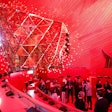With food costs rising, chefs and event planners will have to work together to create exciting menus at just the right price.
“Cost is going up. Gas prices are going up. Delivery costs will be reflected in the prices,” says Brian Stapleton, vice president of food & beverage at Aramark. “It is going to require chefs to be creative and source some things differently.”
Chefs may have to turn to lesser cuts of meat and use different cooking methods or seasonings to create menus that will wow attendees, says Stapleton, who began his career as a sous chef in 1985. He’s worked at hotels across the U.S., including The Carolina Inn, Siena Hotel and various The Ritz Carlton properties.
Stapleton believes this challenge will create new trends in the industry. “Moving forward, the younger generation of chefs will be challenged to use different vegetables out there, different seasonings out there. There is so much available in the marketplace. That’s one of the exciting pieces to me.”
Stapleton, who has also been on the IACC-Americas board of directors for two years, says creating menus for events can be an even bigger challenge—as diverse palates, budgets and goals have to be accounted for.
“When you have a greater level of communication between the client and the people doing the food, you will have a much more dynamic event,” he says. “What I encourage everyone who works in my world is to sit down with the client and manage through what is available in the marketplace. What’s ethnic? What’s regional? What’s artisanal? It’s all about planning. Once you have a plan, then you focus on execution. The problem is when there is a lack of planning or organization.”
The trend of smaller portions at events and restaurants—particularly as costs increase—will continue, but also be helpful, Stapleton says. “You can do a lot of food in smaller portions and offer a variety of flavors on a plate. But you must be cognizant of mouth feels. You must have different textures on the plate.”
Ways to do that include using in-house pickled vegetables or using different grains like farro or black rice.
Stapleton believes the well-traveled attendees has influenced what F&B attendees see at events.
“Because they are international travelers, they are being exposed to different environments and qualities and levels of expectation,” he says. “That’s a huge piece of what you are managing at functions. You are not just serving someone who has been down the street. They are coming with a global viewpoint. Food in a meeting environment is huge and people look forward to the breaks and the social aspects.”
Food can even be part of the meeting, Stapleton points out. It can be part of the educational piece, if there is a health aspect of the meeting. Or food can be part of a sustainability component if the meeting touches on the environment or business. “That all can be built into the menu.”
When it comes to the beverage side of F&B, Stapleton believes the trend will be toward small-batch rum varieties. Distillers in America are already creating small-batch rum.
“These will be sipping beverages, not mixing beverages,” he says. “Rum is going to be a player in the market. Bourbon is not going away, but I’m starting to push rum and market it and have people have a new experience.”
There is also a rising non-alcoholic beverage trend. He’s seen sparkling water taps, much like beer taps, becoming popular at events. The craft soda stations include add-your-own flavors, such as lemon or raspberry. “What’s better than bringing your own creation back into a meeting?”
Stapleton believes educated foodies make coming up with menus for events more fun.
“It’s a challenge,” he says. “But you are no longer putting something on a plate that no one knows what it is. People are interested in food. It’s a fun thing to talk about and socialize around and explore. You have an audience that is interested and has an educated opinion about it.”
F&B Trends: Smaller Portions, Global Flavors, Small-Batch Rum, Craft Sodas
Latest in Meetings















